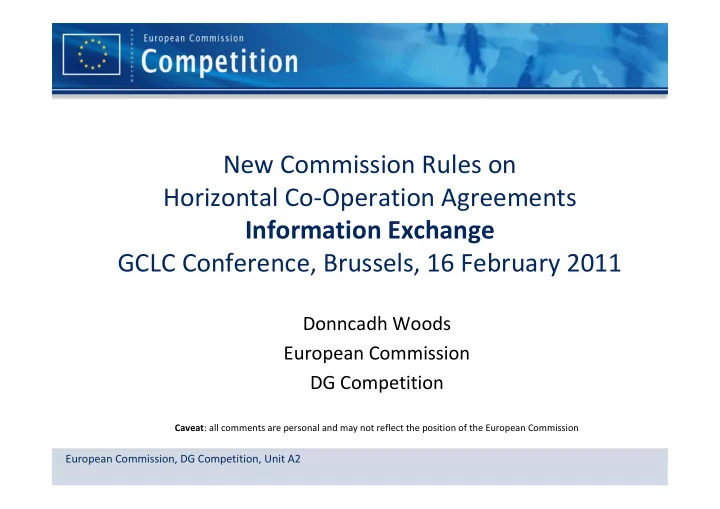

New Commission Rules on Horizontal Co-Operation Agreements Information Exchange GCLC Conference, Brussels, 16 February 2011 Donncadh Woods European Commission DG Competition Caveat : all comments are personal and may not reflect the position of the European Commission European Commission, DG Competition, Unit A2
CONTEXT • Innovation and competitiveness are fundamental to the Commission's Europe 2020 strategy. European Commission, DG Competition, Unit A2
Horizontal Co-Operation Agreements New rules adopted 14 December 2010 COVER: • R&D agreements • Production agreements • Purchasing agreements • Commercialisation agreements • Standardisation agreements and standard terms • Information Exchange • A mix of some of these categories European Commission, DG Competition, Unit A2
Horizontals Review • Main areas of change: – New: guidance on information exchange – Standardisation chapter (“Safe harbour” regarding standard-setting process + guidance outside) – Scope of R&D BER extended to also cover paid-for research (in contrast to “joint” research) – Incremental improvements in other chapters of the guidelines European Commission, DG Competition, Unit A2
Information Exchange • Reasons for new chapter: – Strong stakeholder demand – Complex economics – Case law – Decentralisation – Only sector-specific guidance by Commission European Commission, DG Competition, Unit A2
Information Exchange • Types of information exchanges: – Part of other horizontal agreements – assessed together with such agreements – Ancillary to a cartel (monitoring device) – assessed as part of the cartel – Pure information exchanges – not underpinning any other unlawful conduct – Directly or through third party collecting entity, which then disseminates the data European Commission, DG Competition, Unit A2
Information Exchange • Key features of the new chapter: – Guidance on concerted practices – Guidance on restrictions by object – Relevant factors for assessment of restrictive effects – Efficiencies European Commission, DG Competition, Unit A2
Information Exchange • Restriction by object: – Information exchange between competitors of individualised information regarding intended future prices or quantities European Commission, DG Competition, Unit A2
Information Exchange • Theories of harm regarding restrictive effects: – Collusive outcome: coordination of the firms' behaviour leading to restrictive effects on competition: – Anticompetitive foreclosure European Commission, DG Competition, Unit A2
Information Exchange • Relevant factors for assessment of restrictive effects: – Market characteristics – Characteristics of the information exchange including market coverage – In how far does the exchange modify the market so that a collusive outcome is likely? European Commission, DG Competition, Unit A2
Information Exchange • Efficiencies: – Improving internal efficiencies of firms through benchmarking – Reducing inventories, quicker delivery of perishable products to consumers, dealing with unstable demand – Allocation of production towards high demand markets or low cost firms – Reducing risks of entering new markets – Dealing with problems of information asymmetries – Reduced search costs for consumers (public exchange) European Commission, DG Competition, Unit A2
Questions? Thank you for your attention! European Commission, DG Competition, Unit A2
Recommend
More recommend